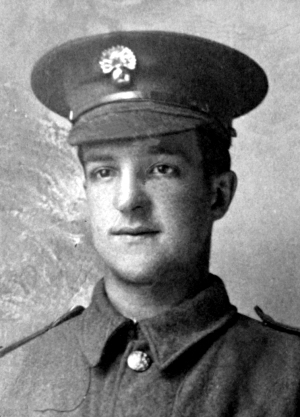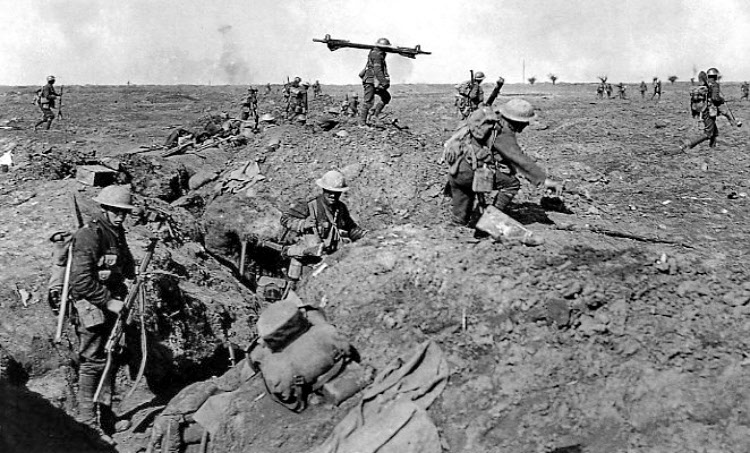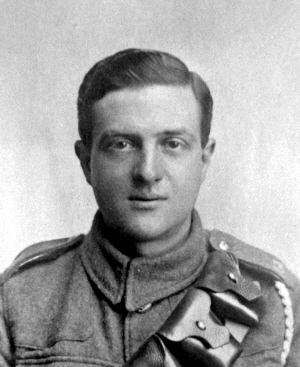 Private George Arthur Pickard, 21510, Grenadier Guards, 4th Battalion
Private George Arthur Pickard, 21510, Grenadier Guards, 4th Battalion
George Arthur Pickard was born in Ossett in late 1895, the younger son of two boys born to Joseph Pickard and his wife, Elizabeth (nee Stacey, formerly Lister), who were married at South Ossett Christ Church on the 4th October 1890. Joseph Pickard was 49 years-old and Elizabeth was a widow aged 38 years-old when they married.
Elizabeth had five children from her first marriage to John Thomas Lister, but three had died before April 1911. She was 45 years of age when George Arthur Pickard was born. In 1901, Joseph and Elizabeth Pickard were living on Manor Road, close to the junction with Station Road. Living with them are their sons, Joseph and George Arthur, a married daughter Alice Jane Fallas, grand daughter Ada Fallas, their 25 year old widowed 'son in law', William Lister and a 15 year-old adopted daughter Maria Ada Fennell.
Only Joseph Pickard senior was working, as a dyer’s labourer. He died, aged 63, in early 1904. In 1911, George Arthur Pickard, now aged 15 years was living with his 60 year-old widowed mother and his brother Joe aged 17, in the six-roomed home of the Fallas in-laws at Dews Yard, The Green, Ossett. George Arthur was working as an errand boy and his brother Joe was working as a gas meter inspector for Ossett Corporation.
At some later stage Elizabeth Pickard and her two sons moved to David Street, off Queen Street, Ossett. Both George and his elder brother Joseph, or Joe, Pickard served in the army in the Great War. George Arthur was killed in action in September 1916 and Joseph was gassed in March 1918, then invalided back home to England, but later returned to the front line.
Joseph Pickard senior did not live long enough to see his two sons enlist in the army, however, he was no stranger to the armed forces himself. On the 2nd April 1871, aged 29 years, Royal Marine Gunner Joseph Pickard was aboard one of Her Majesty’s gun vessels docked at Port Royal, Jamaica in the West Indies. There is a record of a Royal Marine Gunner 1252, Joseph Pickard in 1873/74 aboard the 'Barracuda' in West Africa. He was awarded the Ashanti medal for his service in the Third Ashanti War in what is now Ghana. By 1881, now aged 40 years, Joseph Pickard had returned to the U.K. and was a gunner in the Royal Marine Artillery at their Eastney Barracks at Portsea Island, Hampshire.
George Arthur Pickard’s army service record has not survived, but it is known that he enlisted at Dewsbury and joined the Grenadier Guards with the service number of 21510. He embarked for France on the 15th August 1915 and was killed at the Somme on the 25th September 1916. He was posthumously awarded the British and Victory medals, and also the 1914/15 Star to recognise his service overseas before the 31st December 1915.
The 4th Battalion of the Grenadier Guards was formed at Marlow in 1915 and moved to France on the 14th July 1915. On the 19th August 1915, they came under command of the 3rd Guards Brigade, Guards Division. On the 8th February 1918 they transferred to 4th Guards Brigade in 31st Division and on the 20th May 1918 they transferred to GHQ Reserve.
Private George Arthur Pickard was killed at the Battle of Morval, which took place between the 25th and 28th September 1916. The objective of the 4th Battalion of the Grenadier Guards was the capture of the village of Lesboeufs. The Guards Division "War Diary" provides this information:
"24th September 1916 (Sunday): Trones Wood. The attack was postponed and on Thursday the Battalion was relieved by the Welsh Guards, two companies remaining close up in support trenches and two being taken back to Trones Wood. On Thursday night Lieut. Hon. E. W. Tennant was killed by a sniper and Captain E. G. Spencer Churchill wounded by a shell splinter. 2/Lieut. Constable then took charge of No 4 Company.
On Friday night and Saturday night the Battalion was employed in digging a new communication trench and had a good many casualties while doing it. Orders for attack tomorrow have been received. The 1st and 3rd Guards Brigades attack Lesboeufs, 1st Guards Brigade on the Right of the 3rd Guards Brigade, the 2nd Battalion Scots Guards attack on the Right and 4th Battalion Grenadier Guards on the Left, Scots Guards directing.
The Battalion has by far the hardest job, as we have two lines of German trenches to cross before reaching our First Objective, then there is to be a pause for reforming and at a given time the attack on the Second Objective will commence. The Second Objective being taken, the two Battalions will consolidate on that line and the 1st Battalion Grenadiers will pass through and attack the Third Objective, which is high ground to the N.E. of Lesboeufs.
The Battalion will attack in two lines of two Companies each. No 4 and No 2 in the first line [No. 4 on the Right]. Nos. 1 and 3 in the second line [No. 1 on the Right]. The Battalion moves to its battle position tonight, taking over trenches from the Welsh Guards who are in Brigade Reserve.
25th September 1916 (Monday): 11pm. The Battalion took over its battle position last night. 2/Lieut. Maine hit in the foot. A lot of shelling and bombing. The Artillery bombarded the two lines in front of the Battalion from 10 a.m. to 12 noon but Captain Britten, in a message which reached Battalion HQ at 12:20pm, reported that the fire was weak and inaccurate. At 12:35 p.m. the line advanced to the attack preceded by a creeping barrage 150 yards in advance, which moved at the rate of 50 yards a minute, and a stationary barrage on the Second Objective.
The Battalion was met by a terrific machine and rifle fire which caused very heavy casualties but failed to stop them. The two Left Companys got into the German trench and killed every man there, numbering from 100 to 150; the two Right Companys, who had not met with such heavy opposition passed right on to the First Objective, where later they were joined by the remnants of the two Left Companys.
At 1:35pm the attack on the Second Objective commenced; the Brigade on our Left had failed to reach the First Objective and our Left was totally in the air. Consequently the Right of the attack got forward and attained the Second Objective while the Left only partially got forward. Each unit then dug itself in facing the nearest enemy.
At 2:35pm the 1st Battalion Grenadiers, who had gradually been closed up on the leading line, passed through and attacked the Third Objective. As the Left flank was totally exposed the result was exactly the same; the Right got forward and attained its Objective; the Left was echeloned back and dug in. The Welsh Guards now moved up and filled up gaps forming a continuous line facing North and North East and gradually all units became linked up. 1st Battalion Grenadiers on the Right, on the Third Objective facing East, 2nd Battalion Scots Guards in the Centre facing East and North East and Welsh Guards and the 4th Battalion Grenadier Guards on the Left facing North.
The enemy made several half-hearted counter attacks which were easily repulsed. The 1st Guards Brigade got into and through Lesboeufs and were in touch with the 1st Battalion."
The "Ossett Observer" 1 had an obituary for George Arthur Pickard:
"Private George Arthur Pickard, Grenadier Guards, whose home was in David-street, off Queen-street, Ossett, and who was killed in action on the 25th ult., a comrade, who was wounded at the same time, mentions that the deceased was the first man in the battalion, on going to the front, to volunteer to go out on patrol duty. The writer adds: ' he has done a lot of voluntary work and I can tell you that I should be proud to have had such a brother'. He expresses the opinion that the deceased must have been hit a second time, while trying to get back to his trench, as he did not appear to be badly wounded when his comrade first saw him.
At Sunday's service at the Congregational Church, Ossett Green, a vote of condolence was passed with the relatives of the deceased."

Above: British Infantry at the Battle of Morval on the 25th September 1916.
Private George Arthur Pickard, aged 21 years, son of Mrs. Elizabeth Pickard, of 1, Greenwood's Yard, The Green, Ossett, died on the 25th September 1916. He is remembered on Pier and Face 8D at the Thiepval Memorial, 2 Somme, France. The Thiepval Memorial will be found on the D73, next to the village of Thiepval, off the main Bapaume to Albert road (D929).
On 1 July 1916, supported by a French attack to the south, thirteen divisions of Commonwealth forces launched an offensive on a line from north of Gommecourt to Maricourt. Despite a preliminary bombardment lasting seven days, the German defences were barely touched and the attack met unexpectedly fierce resistance. Losses were catastrophic and with only minimal advances on the southern flank, the initial attack was a failure. In the following weeks, huge resources of manpower and equipment were deployed in an attempt to exploit the modest successes of the first day. However, the German Army resisted tenaciously and repeated attacks and counter attacks meant a major battle for every village, copse and farmhouse gained. At the end of September, Thiepval was finally captured. The village had been an original objective of 1 July. Attacks north and east continued throughout October and into November in increasingly difficult weather conditions. The Battle of the Somme finally ended on 18 November with the onset of winter.
In the spring of 1917, the German forces fell back to their newly prepared defences, the Hindenburg Line, and there were no further significant engagements in the Somme sector until the Germans mounted their major offensive in March 1918.
The Thiepval Memorial, the Memorial to the Missing of the Somme, bears the names of more than 72,000 officers and men of the United Kingdom and South African forces who died in the Somme sector before 20 March 1918 and have no known grave. Over 90% of those commemorated died between July and November 1916. The memorial also serves as an Anglo-French Battle Memorial in recognition of the joint nature of the 1916 offensive and a small cemetery containing equal numbers of Commonwealth and French graves lies at the foot of the memorial.
 George Arthur Pickard's elder brother, Joseph Pickard also served in the Great War. He and his service record has survived. Joseph or Joe Pickard was born in Ossett in late 1892. In August 1916, aged 23 years and 2 months and a clerk and collector in the Rates department of Ossett Borough, he enlisted at Ossett and was posted to army “B” reserve. He was 5’ 8½”, weighed 161 lbs and had a 37” chest measurement. His next of kin was given as his mother, Elizabeth Pickard of 12, David Street, Ossett.
George Arthur Pickard's elder brother, Joseph Pickard also served in the Great War. He and his service record has survived. Joseph or Joe Pickard was born in Ossett in late 1892. In August 1916, aged 23 years and 2 months and a clerk and collector in the Rates department of Ossett Borough, he enlisted at Ossett and was posted to army “B” reserve. He was 5’ 8½”, weighed 161 lbs and had a 37” chest measurement. His next of kin was given as his mother, Elizabeth Pickard of 12, David Street, Ossett.
In a letter, dated 21st September 1916, shortly after Joe’s enlistment, and just four days before his brother George Arthur was killed in action, his doctor from Sowood House, The Green, wrote as follows:
"Joseph Pickard of David Street, Queen Street, Ossett suffers from epilepsy, and disease of the nose for which he was operated upon about two years ago. He still suffers much from headaches and is not, in my opinion, a fit person for active service."
On the 5th March 1917, Mr. T.W. Wilson, the Town Clerk of Ossett Borough Council wrote to the Army indicating that Joe would like to get into the Royal Garrison Artillery adding: "I do not think he would be fit for the trenches as he suffers from epilepsy."
Joe was posted on the 16th March 1917, joining the Royal Garrison Artillery Depot until the 7th April 1917 when he was transferred to Gravesend and then on the 8th August 1917 to the 102nd Siege Battery. His service number was 143648. On the 26th March 1918 he was treated in 55th General Hospital, Boulogne for gas poisoning and he was invalided to England per "Cambria" (Gassed) the same day. After admission to a military hospital for treatment he was moved to a convalescent hospital at Eastbourne on the 30th April 1918. After 46 days, he was discharged on the 15th June 1918.
During a period of furlough, on the 19th June 1918, Joe married Edith Smith at the Congregational Church, Ossett. By October 1918, he was posted to the 538th Siege Battery and subsequently the 519th Siege Battery, Royal Garrison Artillery at Lydd in Kent. He was demobilised on the 18th February 1919 and transferred to “Z” Army Reserve. His home address on his demobilisation record was still 12, David Street, Ossett, but in November 1920 he informs the army of his "correct address" as Hilda Street, Station Road, Ossett.
Gunner Joseph Pickard was awarded the British and Victory medals. As late as the 20th April 1932, Private Joe Pickard’s army file remained open and records a letter from his wife in the following terms:
"Dear Sir, On behalf of Gunner J. Pickard late with the Royal Garrison Artillery, Regt no. 143648, demobilised 18th February 1919, who is now suffering from an abscess on the lung, at present in Dewsbury Infirmary, could you give me the exact date he was gassed in the War. It was in the month of March 1918 and I should like the exact date, which I think you will have in your records, my husband being unable to write himself, I his wife am writing on his behalf, hoping you will oblige me the full particulars required. Yours Truly etc.
p.s. he was in Siege Battery 102 when gassed & Siege Battery 519 when demobilised."
Mrs Pickard was correct in her surmise that the army would have this information in their records, but the army replied to the effect that medical records were confidential and privileged and that it is contrary to the general practice of the Department to make disclosures therefrom.
Joe Pickard died in the Leeds area in 1942.
References:
1. "Ossett Observer", 21st October 1916